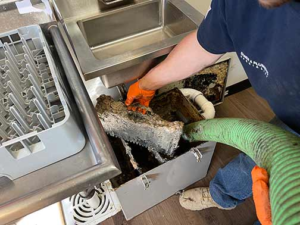Every restaurant, hotel and commercial kitchen needs a grease trap. They reduce the amount of fats, oils and grease (FOG) that enters the sewer waste system.
A grease trap is a receptacle within the drain run that kitchen wastewater flows through before entering the sewer waste system. Grease traps must be pumped regularly. Click the Grease Trap Perth to learn more.

A clean grease trap can prevent unpleasant odors that are a result of clogged drain lines. It can also help reduce the risk of costly sewer backups that affect your business’s revenue. Grease trap odors are caused by the accumulation of fats, oils and grease (FOG), food particles and other contaminants that are discharged from kitchen drains into the grease interceptor or city sewer line. When the FOG and other waste decompose, it creates gasses such as hydrogen sulfide that cause unpleasant smells. Neglected grease traps not only smell bad, they can also pose health risks and contaminate the environment.
The best way to avoid unpleasant odors from your grease trap is through routine cleaning and maintenance. Make sure the trap is cleaned on a schedule that is consistent with your establishment’s usage and system size. Also, make sure the grease trap vent pipes are clear so that odor-causing gasses can escape safely.
During the cleaning process, it’s important to scrape the walls and baffles of your grease trap to remove any adhered grease buildup thoroughly. Regularly flushing the trap with boiling water can also dissolve and dislodge minor buildup. You should also regularly empty the collected grease from your trap into an approved non-hazardous waste collection site.
Keep in mind that the odor-causing gases released by your grease trap are not toxic, but they may be unpleasant for your staff and customers. To reduce the unpleasant odors that are produced, you can use a variety of methods such as adequate ventilation, enclosing the trap, and utilizing odor control products.
Many municipalities require businesses to maintain a clean and functional grease trap in order to prevent pollution and other environmental issues. Failing to meet these requirements can lead to health and safety hazards as well as fines from the local government. Proper prevention techniques, regular cleanings and professional services can greatly reduce or eliminate grease trap odors. To learn more, contact the experts at Goebel Septic Services. We’ll be happy to discuss our preventative maintenance plans, innovative solutions and other services to keep your establishment smelling fresh and running smoothly.
Health
When FOG enters a municipal wastewater system, it can cause blockages and costly repair costs. It can also contribute to environmental contamination and harm aquatic life. The best way to avoid these consequences is to keep FOG out of the sewage system by regularly cleaning your grease trap.
A well-maintained grease trap will not only protect your business, but it can also help you comply with local waste management regulations. Grease trap cleaning services can also help reduce odors that might be offensive to guests and customers. This can lead to an improved customer experience and increased revenue for your business.
Whether you run a restaurant, hotel, or another food service establishment, you know the importance of keeping your kitchen grease trap clean and functioning properly. This will help prevent plumbing issues, clogs, and foul odors that could damage your reputation and deter potential customers. In addition, it will also help extend the lifespan of your equipment.
A poorly maintained grease trap can become a breeding ground for bacteria and other harmful organisms that can affect human health. These organisms can include E.coli, salmonella, and other potentially dangerous pathogens. These pathogens can be transmitted to humans through contaminated water and food, which makes proper grease trap maintenance essential for protecting the health of your customers.
Regular grease trap cleaning can help keep these contaminants out of the sewer system and sewage treatment plants. This can save your business money on plumbing repairs, and it can also prevent expensive fines from your local sewage authority.
Grease traps also promote a healthier environment by keeping FOG out of the sewer system. This can help prevent sewer clogs and backups, which can release raw sewage into the environment. The sewage that is released into the environment can cause environmental contamination and health risks for both humans and animals.
FOG that is not collected by grease traps can also harm the environment by entering rivers and streams. This can contaminate water supplies and make it unsafe to drink. It can also harm the animals that live in these waters by causing injuries or death. The FOG that is collected by grease traps and interceptors can be converted into animal feed, food-safe lubricants, or renewable biofuel.
Safety
Grease traps prevent blockages and backups that put a strain on plumbing systems and kitchen appliances, extending the lifespan of equipment and reducing repair costs over time. Additionally, by intercepting FOG before it reaches the community drainage and sewage system, grease traps help protect local water bodies from contamination that can damage ecosystems.
Maintaining the Flow Rate
The size of your grease trap should be based on your peak flow rate during busy periods, so you can handle the volume of wastewater produced by cooking equipment. Having the right size trap reduces the risk of overflows and allows for consistent flow rates, improving efficiency in the kitchen.
Maintaining Odor Control
Accumulated grease and food particles produce unpleasant odors that can permeate the kitchen and dining areas. Regular cleaning prevents these odors and keeps employees and customers comfortable.
Preventing Health Code Violations
Blockages and backups can put a strain on plumbing systems and kitchen equipment, resulting in costly repairs and replacements over time. By preventing FOG from reaching the sewage system, grease traps help to protect the integrity of pipes and other infrastructure and guard against fines and even closures for violations.
Avoid Chemicals
Using caustic chemicals to clean your grease trap can destroy the positive bacteria and enzymes that make the system work, causing excess waste buildup and making it less effective. Choose a professional company that uses environmentally friendly cleaning solutions that work naturally with your grease trap to keep it at its best.
Train Kitchen Staff
Make sure your team is trained on proper food waste disposal to limit the amount of grease and solids that makes its way into your grease trap. Encourage them to scrape extra food from dishes into trash receptacles rather than sinks, and to use strainers in drains and garbage disposals to keep solid waste out of the system. Also, monitor the level of waste in the trap to gauge when it’s time for a cleaning, and ask your service provider to evaluate the trap periodically to find the ideal service schedule.
Large capacity grease traps are often located on the ground, with a large manhole-type cover that must be securely fastened to prevent workers and patrons from tripping or falling into the pit. If a person falls into the grease trap, they can be seriously injured or killed.
Environment
Grease traps are an integral component of any food service business, and proper maintenance and upkeep are key to keeping them working efficiently. Clogged and inoperable grease traps can cause slow draining, backups, foul odors, and plumbing issues that disrupt business operations and customer satisfaction. Additionally, environmental contamination from FOG that makes its way into the sewer system can result in fines and other legal liabilities for your business.
A well-maintained grease trap can also help reduce your plumbing costs. Regular cleanings and inspections prevent clogs, blockages, and foul odors from forming, which can save you money on expensive repairs and replacements. Additionally, a clean trap can increase its lifespan and improve efficiency by allowing wastewater to flow through more easily.
FOG that isn’t properly captured and disposed of can wreak havoc on pipes and sewer systems, causing blockages and backups that can disrupt wastewater flow and create a health hazard for workers. Moreover, it can harm the environment by entering waterways where it can contaminate drinking water and create a health risk for wildlife. Grease traps work to collect this contaminant before it enters the sewer system, and recycling FOG waste allows us to repurpose this material for other uses that benefit the environment.
Many grease traps are designed to be unobtrusive, taking up minimal space in a commercial kitchen and hiding away underneath sinks or in corners. However, even the most efficient grease trap can become clogged if improper food waste or cleaning practices are used. It’s important for businesses to train their employees on best practices when it comes to using kitchen equipment and disposing of food scraps and harsh chemicals.
Avoid pouring excess fats, oils, and grease down the drain, and instead, scrape food residue from plates before rinsing them. Similarly, be sure to use sink drain covers and toss expired cooking oil into a trash can. These simple practices can significantly cut down on the amount of FOG your grease trap has to collect, extending its life and reducing your maintenance and pumping needs. In addition, consider partnering with professional liquid waste management services like WASTECO to ensure your trap is properly maintained and pumped on schedule.




